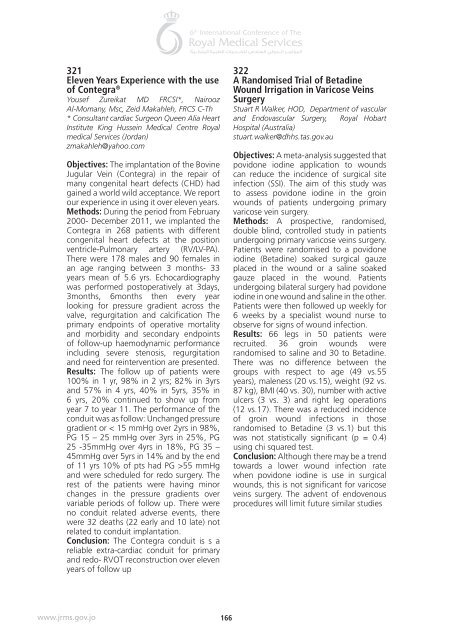Abstract book 6th RMS 16.indd
Abstract book 6th RMS 16.indd
Abstract book 6th RMS 16.indd
You also want an ePaper? Increase the reach of your titles
YUMPU automatically turns print PDFs into web optimized ePapers that Google loves.
321<br />
Eleven Years Experience with the use<br />
of Contegra ®<br />
Yousef Zureikat MD FRCSI*, Nairooz<br />
Al-Momany, Msc, Zeid Makahleh, FRCS C-Th<br />
* Consultant cardiac Surgeon Queen Alia Heart<br />
Institute King Hussein Medical Centre Royal<br />
medical Services (Jordan)<br />
zmakahleh@yahoo.com<br />
Objectives: The implantation of the Bovine<br />
Jugular Vein (Contegra) in the repair of<br />
many congenital heart defects (CHD) had<br />
gained a world wild acceptance. We report<br />
our experience in using it over eleven years.<br />
Methods: During the period from February<br />
2000- December 2011, we implanted the<br />
Contegra in 268 patients with different<br />
congenital heart defects at the position<br />
ventricle-Pulmonary artery (RV/LV-PA).<br />
There were 178 males and 90 females in<br />
an age ranging between 3 months- 33<br />
years mean of 5.6 yrs. Echocardiography<br />
was performed postoperatively at 3days,<br />
3months, 6months then every year<br />
looking for pressure gradient across the<br />
valve, regurgitation and calcification The<br />
primary endpoints of operative mortality<br />
and morbidity and secondary endpoints<br />
of follow-up haemodynamic performance<br />
including severe stenosis, regurgitation<br />
and need for reintervention are presented.<br />
Results: The follow up of patients were<br />
100% in 1 yr, 98% in 2 yrs; 82% in 3yrs<br />
and 57% in 4 yrs, 40% in 5yrs, 35% in<br />
6 yrs, 20% continued to show up from<br />
year 7 to year 11. The performance of the<br />
conduit was as follow: Unchanged pressure<br />
gradient or < 15 mmHg over 2yrs in 98%,<br />
PG 15 – 25 mmHg over 3yrs in 25%, PG<br />
25 -35mmHg over 4yrs in 18%, PG 35 –<br />
45mmHg over 5yrs in 14% and by the end<br />
of 11 yrs 10% of pts had PG >55 mmHg<br />
and were scheduled for redo surgery. The<br />
rest of the patients were having minor<br />
changes in the pressure gradients over<br />
variable periods of follow up. There were<br />
no conduit related adverse events, there<br />
were 32 deaths (22 early and 10 late) not<br />
related to conduit implantation.<br />
Conclusion: The Contegra conduit is s a<br />
reliable extra-cardiac conduit for primary<br />
and redo- RVOT reconstruction over eleven<br />
years of follow up<br />
322<br />
A Randomised Trial of Betadine<br />
Wound Irrigation in Varicose Veins<br />
Surgery<br />
Stuart R Walker, HOD, Department of vascular<br />
and Endovascular Surgery, Royal Hobart<br />
Hospital (Australia)<br />
stuart.walker@dhhs.tas.gov.au<br />
Objectives: A meta-analysis suggested that<br />
povidone iodine application to wounds<br />
can reduce the incidence of surgical site<br />
infection (SSI). The aim of this study was<br />
to assess povidone iodine in the groin<br />
wounds of patients undergoing primary<br />
varicose vein surgery.<br />
Methods: A prospective, randomised,<br />
double blind, controlled study in patients<br />
undergoing primary varicose veins surgery.<br />
Patients were randomised to a povidone<br />
iodine (Betadine) soaked surgical gauze<br />
placed in the wound or a saline soaked<br />
gauze placed in the wound. Patients<br />
undergoing bilateral surgery had povidone<br />
iodine in one wound and saline in the other.<br />
Patients were then followed up weekly for<br />
6 weeks by a specialist wound nurse to<br />
observe for signs of wound infection.<br />
Results: 66 legs in 50 patients were<br />
recruited. 36 groin wounds were<br />
randomised to saline and 30 to Betadine.<br />
There was no difference between the<br />
groups with respect to age (49 vs.55<br />
years), maleness (20 vs.15), weight (92 vs.<br />
87 kg), BMI (40 vs. 30), number with active<br />
ulcers (3 vs. 3) and right leg operations<br />
(12 vs.17). There was a reduced incidence<br />
of groin wound infections in those<br />
randomised to Betadine (3 vs.1) but this<br />
was not statistically significant (p = 0.4)<br />
using chi squared test.<br />
Conclusion: Although there may be a trend<br />
towards a lower wound infection rate<br />
when povidone iodine is use in surgical<br />
wounds, this is not significant for varicose<br />
veins surgery. The advent of endovenous<br />
procedures will limit future similar studies<br />
www.jrms.gov.jo<br />
166

















